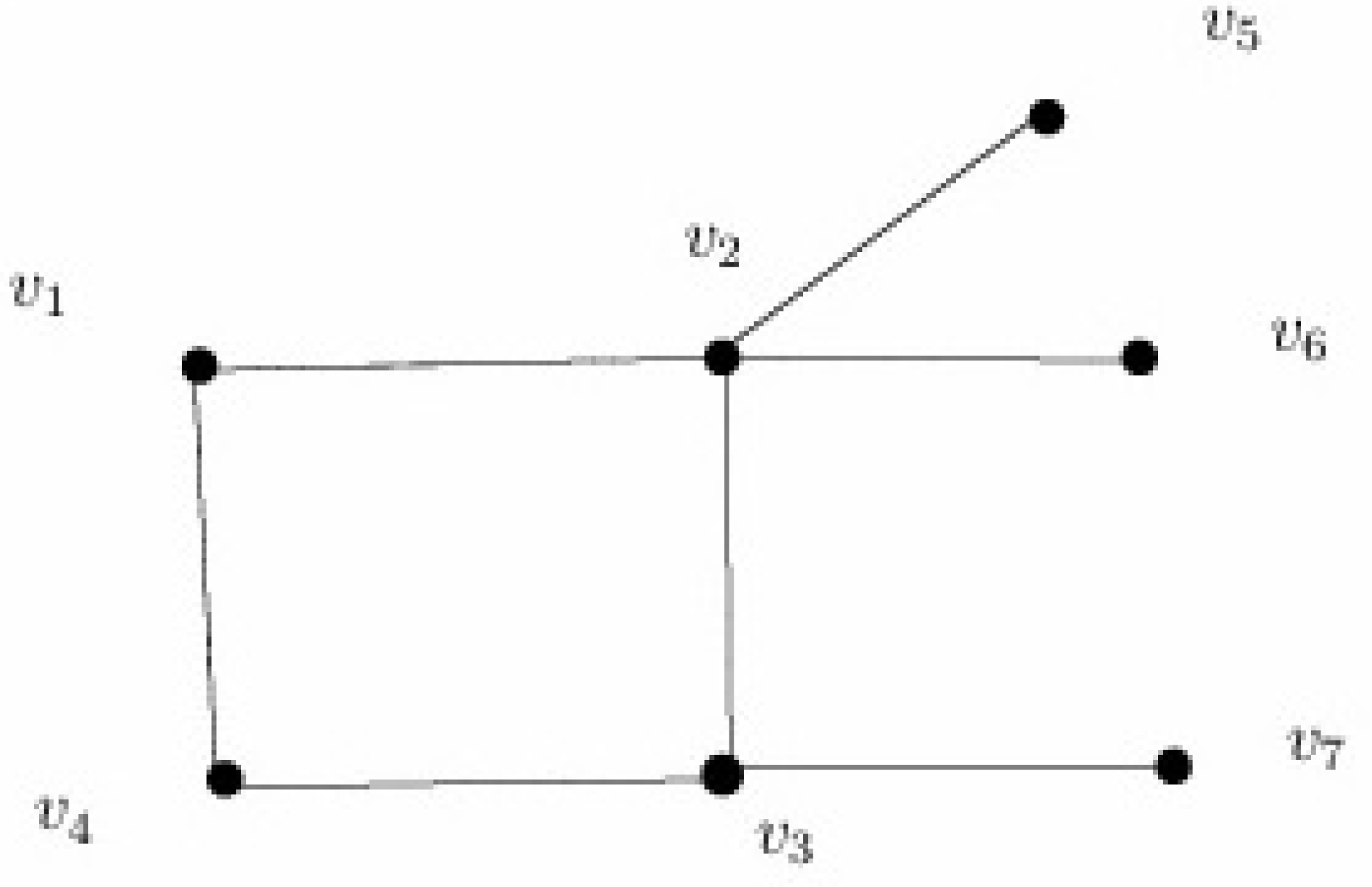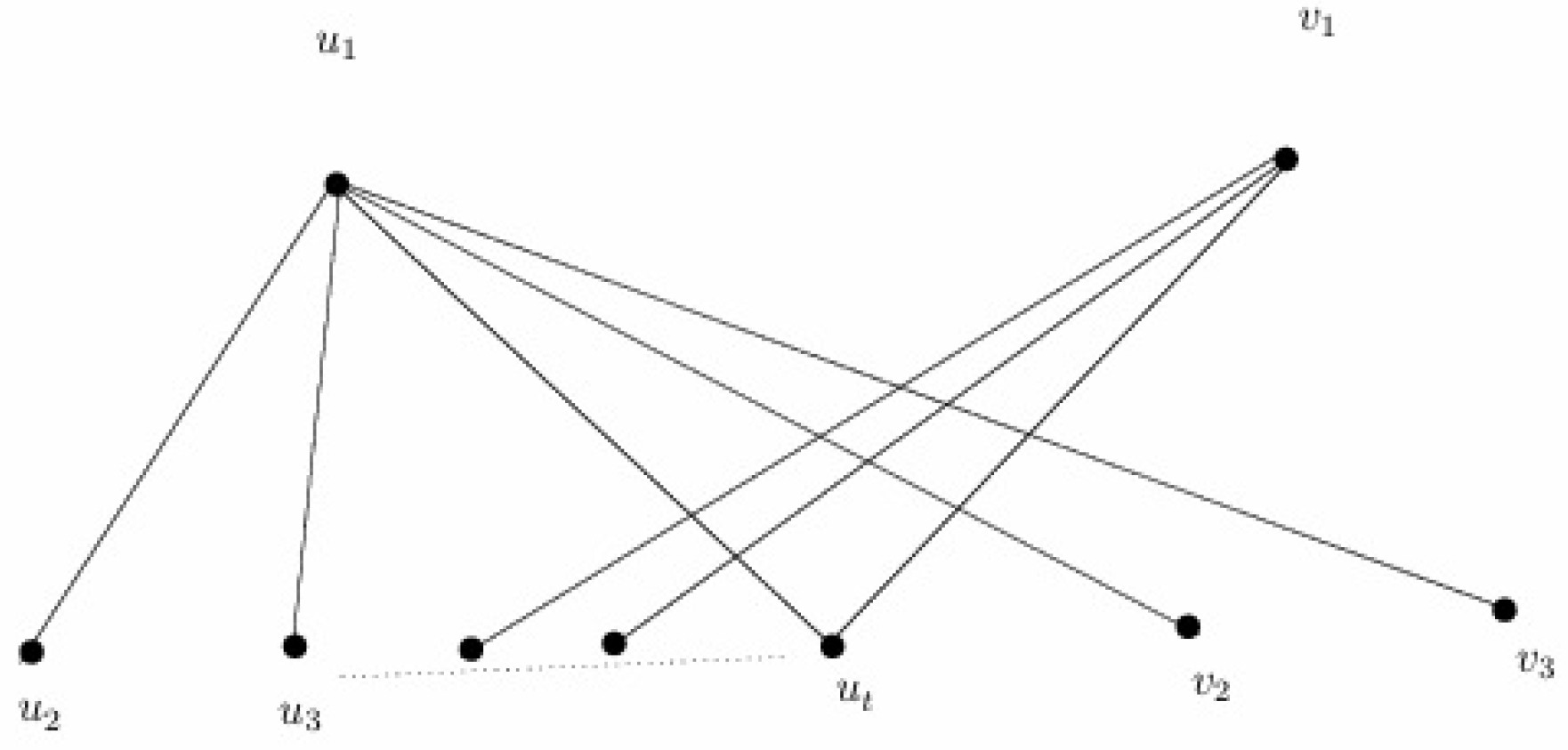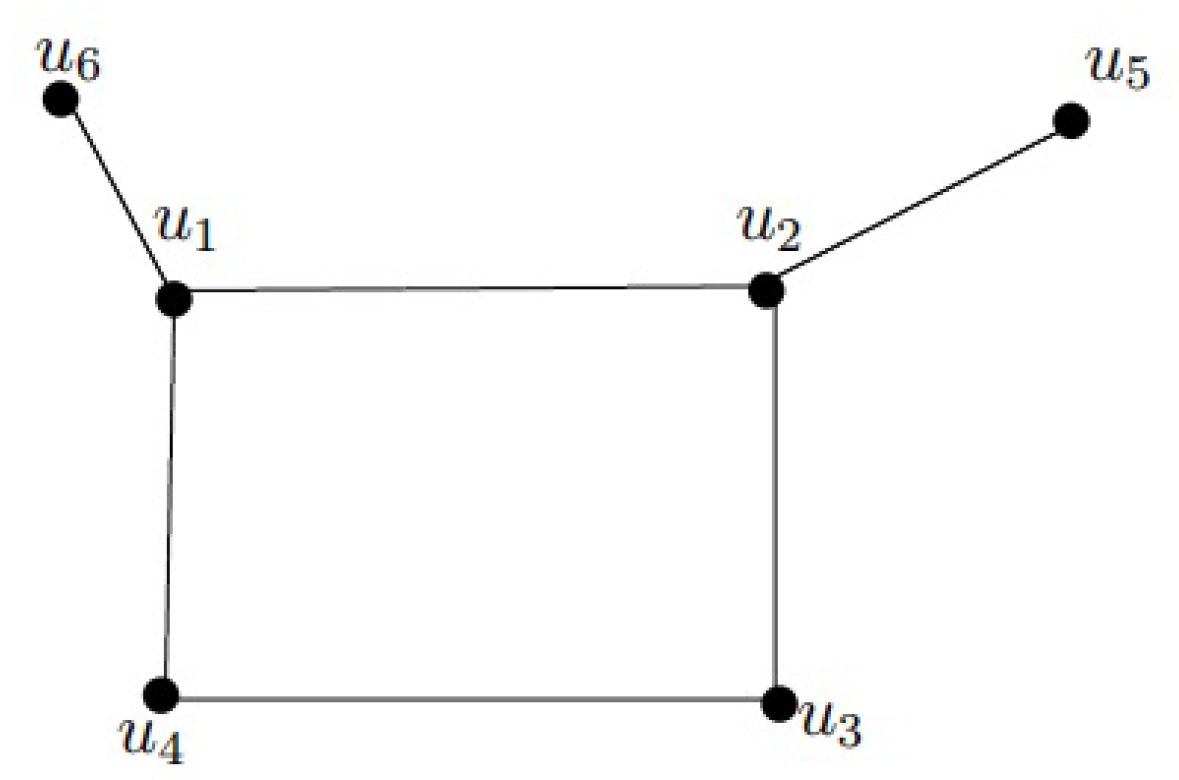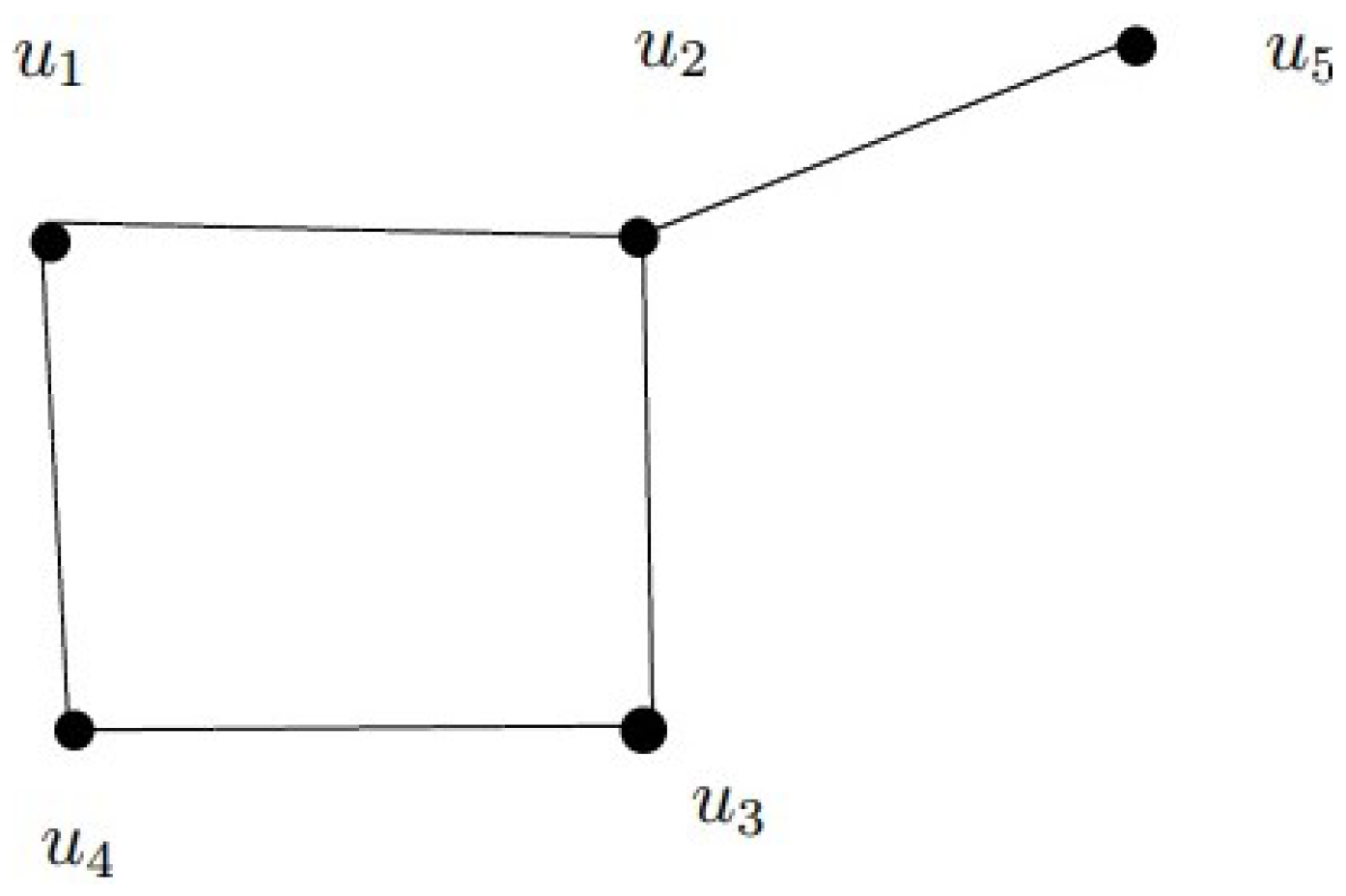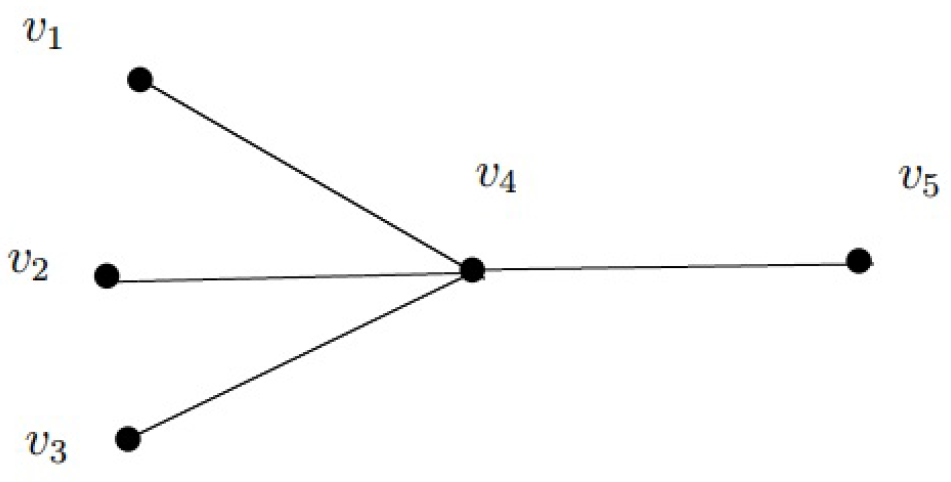1. Introduction
All the undefined notations and terminologies have been introduced in
Section 2.
Domination-related graphical parameters have immense applications in computer science, engineering and chemistry. The earliest domination-related parameters were reported in the book by Ore [
1]. Over the years, diverse variants of the domination number in graphs have been proposed and studied. Some of the variants include the locating-dominating number,
k-domination number and the Roman domination number, among others. There is a rich amount of the literature which has been published on the domination theory of graphs. For instance, Atakul [
2] investigated the domination exponential and stability in certain families of graphs. Li [
3] derived some upper/lower bounds on the Roman domination numbers of graphs. Hernández-Ortiz et al. [
4] studied the weak Roman domination in certain infinite families of rooted product graphs. Cabrera-Martínez & Peiró [
5] investigated the
-domination number of graphs with
For a detailed survey of the mathematical results on the domination theory of graphs, we refer the reader to Haynes et al. [
6].
Well-covered graphs constitute an important class of graphs introduced by Ravindra [
7] back in 1977. They have been extensively studied since then. For instance, Favaron [
8] extended the notion of well-covered graphs and introduced very well-covered graphs. Finbow et al. [
9] characterized well-covered graphs with a girth greater than or equal to 5. King [
10] classified a subclass of well-covered networks. For the well-coveredness of product graphs with such strong products of graphs, Topp & Volkmann [
11] published some results. Recently, in 2018, Cartesian product graphs with well-covered properties were investigated by Hartnell et al. [
12].
Well-dominated and
k-extendable graphs form another structurally important class of graphs. In 1992, Anunchuen & Caccetta [
13] introduced and studied critically
k-extendable graphs. Well-dominated graphs first appeared in a seminal paper by Finbow et al. [
14], who introduced them in the context of well-covered graphs. The well-dominated properties of a graph have an extensive amount of published results. Topp & Volkmann [
15] in 1990 studied the well-coveredness and well-dominated properties of uniclycic as well as block graphs. Zverovich & Zverovich [
16] proposed locally independent well-dominated and locally well-dominated graphs and showed some structural results. Gözüpek et al. [
17] investigated the well-dominated property of graphs obtained from the lexicographic product of two graphs. Graphs which are
-free have been studied in the context of well-dominated properties by Levit & Tankus [
18]. Alizadeh & Gözüpek [
19] investigated bipartite graphs
H, which are almost well-dominated having
(the minimum degree in
H of at least 2). For a survey on well-dominated graphs, we suggest the readers turn to a survey by Anderson et al. [
20]. Recently, in 2023, Rall [
21] studied the well-dominated properties of strong, direct and Cartesian product graphs.
There have been numerous recent developments on well-dominated, well-covered and
k-extendable graphs. For instance, in addition to introducing the classical well-dominated graphs, Anderson et al. [
22] introduced the edge version of the well-dominated graphs. Kuenzel & Rall [
23] in 2024 classified the well-dominated Cartesian product of graphs. In their seminal paper, Crupi et al. [
24] investigated very well-covered graphs by algebraic structures such as Betti splittings. By putting certain conditions on
(largest degree) and
(smallest degree), Levit & Tankus [
25] investigated well-covered graphs. Alves et al. [
26] solved the graph sandwich problem in the context of partitions and well-coveredness. Regarding
k-extendable graphs, Gan et al. [
27] studied the
k-extendability of Cayley graphs generated by transpositions. Feng et al. [
28] investigated Hamiltonian cycle properties in
k-extendable non-bipartite graphs with high connectivity. For implementation of machine learning by employing graph theory such as graph neural networks, we refer to [
29,
30,
31,
32,
33].
In this paper, by extending the concept of
k-extendable graphs, we introduce
-endowed graphs. We characterize minimal dominating sets in
-endowed graphs and study their well-dominated property. We also introduce and study the symmetric
-endowed graphs and prove some structurally important results. In this work, an open problem (from Khan [
34]) asking to find a domination-dependent graphical descriptor delivering a correlation coefficient of
with the total
-electronic energy
of lower benzenoid hydrocarbons (BHs) has been solved.
Section 6 shows that the upper domination number studied in this paper delivers a correlation coefficient
with
of lower BHs. A regression model is also proposed with a detailed statistical analysis for structure–property studies of the
of lower BHs.
2. Preliminaries
Consider a simple graph
where the number of vertices adjacent to a given vertex
is denoted by
The graph’s minimum and maximum degrees are represented by
and
respectively. The set of vertices adjacent to
v in
H is designated as
and the closed neighborhood of
v is defined as
The complement of a graph
denoted as
is characterized by vertices being adjacent only if they are non-adjacent in
For a subgraph
G of
its vertex and edge sets are denoted as
and
respectively. Two subsets
satisfying
and
form a bipartition
if for any
we have
and
or vice versa. Various well-known graph structures are hereby identified, including the
n-dimensional complete graph
, cycle graph
, path graph
and the
-dimensional complete bipartite graph
. Note that the start graph is merely the complete bipartite graph
. In a connected graph, it is noteworthy that every pair of vertices is connected by a path. A subset
is said to be an independent set if no pair of vertices of
T are adjacent in
H. The maximum cardinality of an independent set is called the independence number
of
H. For basic definitions, we refer the reader to [
35,
36].
A subset
T within the vertex set
is termed a dominating set (DS) of graph
H if, for each vertex
v in the complement of
T there exists a vertex
u in
T such that
u and
v are adjacent. It is noteworthy that any superset of a dominating set of
H also qualifies to be a dominating set of
H [
6,
37]. Moreover, a dominating set
T of
H is categorized as a minimal dominating set of
H if no proper subset of
T possesses the property of being a dominating set of
H. Minimal DSs of a graph have been characterized by Ore in his famous Ore’s theorem. A vertex
is said to be a private neighbour (
) of
with respect to
T denoted by
if
. A DS
T is minimal if and only if the private neighboured set of any vertex of
T is non-empty. Note that any DS of
H contains a minimal DS of
H.
The smallest (resp. largest) cardinality of a minimal DS in graph H is termed as the domination number () (resp. upper domination number (). A DS is characterized as an independent DS if all the vertices in it are independent (i.e., mutually non-adjacent). The cardinality of the smallest independent DS is defined as the independent domination number and is represented by For instance, in the star graph where the set of pendant vertices qualifies to be a DS, however, it does not encompass a minimal DS.
Berge [
38] initiated the study of independent sets being contained in maximum independent sets. The natural curiosity is to start a similar study of DSs comprising a minimum DS. The minimum cardinality of such DSs are called
-sets. Some dominating sets of a graph contain a minimum dominating sets while some may not. Claude Berge in 1980 defined
k-extendable graphs as those in which any independent set of cardinality
k is part of a maximum independent set of the graph. Graphs which are 1-extendable are called Berge graphs. This has led to the concepts of well-covered and well-dominated graphs. Analogous to
k-extendable graphs, the concept of
-endowed graphs is being introduced in this paper.
In -endowed graphs, every dominating set of cardinality k contains a minimum dominating set of the graph. Alternatively, a dominating set of a graph H containing a minimum dominating set of H is called a -endowed dominating set of H. If that set is of cardinality k then it is called a -endowed dominating set. If in a graph H, minimal dominating sets of cardinality greater than exist, such sets will not qualify to be -endowed. Moreover if , then every dominating set of H contains a minimum dominating set of This is one extreme. The other extreme is that for every positive integer , there exists a minimal dominating set of H of cardinality k. The former concept is well-known and named as well-dominated graphs. In this article, we discuss the results related to -endowed graphs.
4. Graphs with Unique Minimum DS
In this section, we study unique minimum dominating sets in -endowed graphs.
Proposition 1. Consider a simple graph H possessing no isolated members. If H has a unique minimum DS, then H is not -endowed for any where .
Proof. Suppose T is the minimum DS of As H possesses no isolated members, is a DS of T and Hence H is not -endowed if Also, for any where is a subset of T of cardinality is a DS of H not containing Hence H is not -endowed if □
Proposition 2. Let H be a graph without isolated members. Let be a unique minimum DS of Every vertex has at least two in with respect to (That is, ).
Proof. Assume that lacks a pendant neighbor () in the set with respect to In this scenario, is an isolated member in the induced subgraph As is not an isolated member in the original graph there must exist a vertex Let Note that any ’s neighbor (resp. the vertices ) is dominated by (resp. v). Consequently, qualifies as a minimum DS of leading to a contradiction.
Hence, it is established that every vertex in T must have a pendant neighbor in Now, let us consider the case where possesses exactly one pendant neighbor in concerning Denote the sole pendant neighbor of as Form the set In this configuration, v dominates and any neighbor of (excluding v) is dominated by Therefore, constitutes a minimum DS of resulting in a contradiction.
Consequently, it can be concluded that each vertex must have at least two pendant neighbors in with respect to T. □
Remark 3. Let H be a graph without isolated members. Assume is a unique minimum DS of H. Let and Then is a DS of H of cardinality since ).
Proposition 3. Suppose H is a graph possessing no isolated members. Assume is a unique minimum DS of Then,
Proof. Suppose for some Let and let be a DS of Then, is a DS of H with number of members a contradiction. Therefore, □
Corollary 1. The induced graph has no full degree vertex for every
Remark 4. Let H be a graph without isolated members. Assume is a unique minimum DS of Let . Then, for any such that there exists a DS of cardinality These DSs do not contain Therefore, H is not -endowed for all with
There exists a graph with the unique minimum DS which is not -endowed and which is -endowed. For example, consider then H is not -endowed, however, H is -endowed.
There exists a graph with a unique minimum DS which is -endowed and which is not -endowed and is large. Let Then, H has a unique minimum DS and Moreover, H is -endowed, H is not -endowed for all Hence,
Let H be a graph without isolated members. Let be a unique minimum DS of H. Let . Then, H is not a -endowed for k satisfying
Consider where Then, H is not -endowed for and H is -endowed for all and
Proposition 4. Assume to be the minimum satisfying and H contains a minimal DS of cardinality Then, H is a -endowed for all
Proof. Let T be a DS of cardinality by hypothesis, T is not minimal and T cannot contain a minimal DS other than a -set. Therefore, T is a -endowed. □
Corollary 2. Under the hypothesis of the above remark and assuming H is not trivially γ-endowed.
Remark 5. There exists a graph H with a unique minimum DS such that every DS of cardinality contains the unique minimum DS.
Example 3. The star .
For the graph H in Figure 2, any DS of cardinality 5 contains T. There exists a DS of cardinality 6, namely which does not contain Therefore, H is not a -endowed. In fact, H is not -endowed for any k such that
Remark 6. Let H be the graph without isolated members. Let T be the unique minimum DS of Let and . Moreover, let where Therefore, H is not -endowed. Therefore, H is not -endowed for all such that
Theorem 1. Suppose H is a graph without isolated members with a unique minimum DS Let . Then, H is -endowed for and not -endowed if provided If and , then H is -endowed if and not -endowed if .
Proof. Let T be a unique minimum DS of Let Suppose . Since any vertex of T has at least ℓ s in Therefore, Since that is a contradiction.
Case (i): Therefore, that is Therefore, Let If then any DS of cardinality t contains T. Therefore, for all , such that H is -endowed. Therefore, for all such that H is not -endowed.
Subcase (i): Then Therefore, (since ), a contradiction.
Subcase (ii): Then, Therefore, Proceeding as in case (i), we obtain the result.
Subcase (iii): Then, Therefore, . That is, If then any DS of H must contain
Suppose is a DS of H of cardinality Suppose does not contain Then, for any vertex in of that vertex belong to Suppose does not contain t vertices of Therefore, contains vertices from Therefore, Therefore, Since Therefore, therefore, thus, Hence, contains every vertex of Thus, H is -endowed for If then there exists a DS of cardinality not containing a vertex for which Hence, H is not -endowed for with □
Corollary 3. Let . Then, is -endowed if and is not -endowed if
Proof. Since and has a unique minimum DS T consisting of the two centers, say, and if supports r pendant vertices. Since Also since Therefore, by Theorem 1, is -endowed if and is not -endowed if That is, is -endowed if and is not -endowed if □
Remark 7. is trivially γ-endowed if
Theorem 2. Suppose H is a graph without isolated members. Assume u is a γ-fixed member of H. Let is a γ-set of . Then, H is not -endowed for all
Proof. Suppose T is a minimum DS of H satisfying is minimum. Let and Then, is a DS of H. Since we have that does not contain any -set of H. Therefore, H is not -endowed and hence H is not -endowed for all □
Here we have a subsequent corollary to Theorem 2.
Corollary 4. When H is trivially γ-endowed.
Theorem 3. Let H be a graph without isolated members in which Suppose there exists a minimum independent DS T in which at least one vertex, say u, has a in with respect to Then, H is not -endowed for and
Proof. Suppose T is a minimum independent DS of H. Then, Moreover, by hypothesis, existence of a is ensured, satisfying Let and . Suppose contains a minimum DS, say S of H. Clearly, Therefore, Since Let Since v can dominate at most one of Since contains independent vertices of no vertices of can dominate as well as a contradiction, since S is a DS of Therefore, does not contain any minimum DS of Therefore, H is not -endowed. □
Remark 8. Consider where , then and . The partite set with n elements constitutes a minimum independent DS and no vertex of this set has a in the complement.
For the graph H in Figure 3, is the only minimum DS of H and is a minimum independent DS of H. Therefore, The subsets and are a DS of H not containing any γ-set of H. Therefore, H is not -endowed for and 5. See Figure 3.
Proposition 5. Suppose H is a graph having no isolated members in which Suppose there exists a minimum independent DS named satisfying Let for Then, H is not -endowed for
Proof. Assume is a minimum independent DS of H. Let Let for and Suppose S contains a -set of H, say, Since T is a minimum independent DS of Then, T is minimal DS of Therefore, and Moreover, let Therefore, dominates Also (since every vertex of is a of some vertex of Therefore, a contradiction, since □
Remark 9. Assume T is a minimal independent DS of Let Assume satisfies Let for Then, H is not -endowed for
Remark 10. Existence of a graph H is depicted in Figure 4 with and H is not -endowed for all k. We have the following: γ-set: -set:
Figure 4.
The graph H in Remark 10.
Figure 4.
The graph H in Remark 10.
Theorem 4. Assume an n-vertex graph H comprises a minimal DS of cardinality , then
- (i)
if H has exactly isolated members.
- (ii)
if H has exactly isolated members and the remaining vertices form a star.
Proof. Let T be a minimal DS of cardinality Let and let Then, is adjacent to some point of D, say, .
Case (i):T is independent. Then, H is where Thus,
Case (ii):T is not independent. Let WLOG assume that . Then, is adjacent with exactly one of (since T is minimal). Therefore, This implies that where and □
Corollary 5. Consider a graph H with an order of The graph H possesses a minimal DS of cardinality if and only if H can be expressed as where
Let H be a graph of order n with a minimal DS of cardinality In such a case, H is trivially γ-endowed if and only if H takes the form where . Alternatively, if H is an n-vertex graph with then H is trivially γ-endowed if and only if H is either or
Example 4. Figure 5 presents a graph H with . Remark 11. Example 4 implies that there are graphs H in which and and H is -endowed for all except when
Example 5. Figure 6 exhibits a graph H having and Theorem 5. Let be such that any minimum DS of H either contains u or v. Suppose there exists a DS of cardinality not containing u and Then, H is almost trivially γ-endowed, that is, H is not -endowed for all
Proof. Let T be a DS of cardinality not containing u and v. For any w not equal to , we have that is a DS of cardinality and it does not contain any minimum DS of In general, if the set is a DS of cardinality and this does not contain any minimum DS. Thus, H is not -endowed for all □
Corollary 6. Suppose exist, satisfying the condition that any minimum DS of H either contains u or contains v and there exists a DS of cardinality not containing u and v. Moreover, if H is not -endowed, then H is trivially γ-endowed.
Observation 2. If H is -endowed for all except for exactly one value of say, l then in the sequence there are only two distinct values, as well as any minimal DS of H or a Γ-set (a minimum DS with cardinality ) of The following two graphs satisfy the above property:
- (i)
Let Then, and H is -endowed for all except for
- (ii)
Assume the graph H is obtained from by joining one vertex of one with exactly one vertex of another . See Figure 7.
Consider Suppose or Then, or Moreover, For this class of graphs H, the graph H is -endowed for all except for
5. Symmetric -Endowed Graphs
First, we define the symmetric -endowed graphs.
Definition 2. A graph H is said to be symmetric γ-endowed if for every H is -endowed.
Let us illustrate this concept by studying it for standard families.
Example 6. are symmetric γ-endowed.
are not symmetric γ-endowed.
Observation 3. A graph H is symmetric γ-endowed if and only H is well-dominated.
Proof. Let H be well-dominated. Then, we have Let T be any DS of H of cardinality Then, D contains a minimal DS of But, any minimal DS of H is a minimum DS of Therefore, H is -endowed. Therefore, H is symmetric -endowed. Conversely, if H is symmetric -endowed then and hence H is well-dominated. □
Proposition 6. The polygon is symmetric γ-endowed if and only if and 13. Moreover, and
Proof. If and and hence there exists a DS of cardinality which does not contain a minimum DS. If or 2 (mod k) and then There exists a DS of cardinality which does not contain a minimum DS. It can be easily verified that and are not -endowed. The same goes for and . □
Observation 4. A complete bipartite graph is not symmetric γ-endowed.
Lemma 1. Let H be a simple graph in which . Suppose H is -endowed, then H is -endowed for all
Proof. Let T be a DS of H of cardinality Then, T contains a minimal DS of H. Suppose D does not contain a minimal DS of Then, T contains a -set S of Since Let Then, is a DS of cardinality By hypothesis, is -endowed. There exists a -endowed set, say , which is contained in and hence contained in □
As a converse to Lemma 1, we have:
Lemma 2. Let H be a simple graph which is not well-dominated. Suppose H is -endowed for all then .
Proof. Since H is -endowed for all or Since H is not well-dominated, Therefore, □
Proposition 7. Let H be a simple graph. H is -endowed for all k except if and only if and H is -endowed.
Proof. If and H is -endowed then by the Lemma 2, H is -endowed for all k except
Conversely, if H is -endowed for all except for then and clearly H is -endowed. □
Remark 12. There are graphs in which and H is not -endowed. For a graph H in Figure 8, consider that is the unique minimum DS of H Moreover, are Γ-
sets of Any four or five element DS of H contains either or any of the Γ-
set of this graph is not -endowed since is a DS of cardinality and this set does not contain the unique minimum DS of Theorem 6. Let H be a simple graph which is -endowed for all k except Then, for any - set T of H and for any the existence of two vertices is ensured, satisfying
Proof. By hypothesis, Let D be a - set of Then, by using the hypothesis that “ is a DS”, we obtain that H contains a -endowed set, say . We have that where that is, for any . This implies that there exists two vertices such that □
Example 7. Consider the graph H in Figure 9. The sets are the γ-endowed sets of H. is a - set of is a γ-endowed set of is a γ-endowed set of Moreover, Example 8. There exists a graph H with and H is -endowed. See Figure 10. Let Therefore Any DS of cardinality D with containing the central vertex is, in fact, a minimum DS. Therefore, H is -endowed for and 5. Therefore, H is -endowed.
Example 9. In , we have and H is -endowed for all except when In this graph, we have and H is -endowed.
6. Application of in QSPR Models
This section investigates a significant applicability of the upper domination number within the context of QSPR studies of benzenoid hydrocarbons (BHs).
The total
-electron (
) energy in BHs that can be modelled through structure–property relationships has emerged as an active research field. Notably, Luči’c et al. [
39] demonstrated a close interrelation between product/sum-connectivity descriptors, which exhibit significant accuracy in predicting
for BHs. Their study focused on a selection of 30 BHs as test molecules. Subsequently, their work was expanded by Luči’c et al. to encompass generalized versions of these connectivity descriptors denoted as
and
, identifying optimal values (
and
) that offer superior predictive capabilities for
in BHs. Furthermore, Hayat and coauthors [
40] (and Hayat et al. [
41]) investigated the estimation ability of valency-related (and distance-dependent) indices commonly observed in BHs. For insights into the effectiveness of eigenvalue-dependent spectral descriptors in
prediction for BHs, readers are directed to [
42,
43]. Additionally, recent advancements in QSPR models for chemical/physical characteristics in biomolecular networks as well as nano-structures have been discussed in [
44,
45,
46,
47,
48]. For the predictive potential of graphical indices for thermodynamic properties of benzenoid hydrocarbons, we refer the reader to [
49,
50,
51,
52]. For the structure–property modeling of different chemical properties of a specific set of test molecules, the reader is referred to [
53,
54,
55].
In a recent work, Khan [
34] carried out a comparison analysis of seven domination-dependent graphical descriptors (excluding
), aiming to establish correlations with the
of lower BHs. Among these parameters, the work by Khan [
34] showcased that the paired-domination number
exhibits the most significant capability, showing a high correlation number of
. The following question was raised by concluding the investigation.
Problem 7. Find a domination-dependent graphical descriptor γ for which the correlation coefficient of lower BHs exceeds ?
This section addresses Problem 7 and demonstrates that the upper domination number
yields an enhanced correlative capability, with
of BHs exhibiting
. To demonstrate this, 30 lower BHs as suggested by Khan [
34] were opted.
Figure 11 displays the BHs investigated in this analysis.
Subsequently, we determine the locating–dominating number
for the 30 BHs depicted in
Figure 11. The values of the locating–dominating number
and
, measured in units of
, are presented in
Table 1 for the 30 lower BHs shown in
Figure 11. Utilizing
Table 1’s data, we conducted thorough regression and correlation analyses. Initially, the correlation coefficient valuing
was calculated, which is considerably higher than the minimum value of
. Subsequently, a comprehensive statistical data investigation was carried out. The most significant data-fitting regression model suggested by data analysis is linear. The subsequent details include a regression equation with 95% estimated confidence values and other important statistical values derived from
Table 1.
Subsequently, we present the scatter plot depicting the relationship between
and
for 30 lower BHs. Refer to
Figure 12.
Table 1.
and the upper domination number of 30 lower BHs (View
Figure 11).
Table 1.
and the upper domination number of 30 lower BHs (View
Figure 11).
| Molecule | | |
|---|
| Benzene | 8 | 3 |
| Naphthalene | 13.6832 | 5 |
| Phenanthrene | 19.4483 | 7 |
| Anthracene | 19.3137 | 7 |
| Pyrene | 22.5055 | 9 |
| Tetracene | 24.9308 | 9 |
| Benzo[a]anthracene | 25.1012 | 9 |
| Benzo[c]phenanthrene | 25.1875 | 9 |
| Chrysene | 25.1922 | 9 |
| Triphenylene | 25.2745 | 9 |
| Benzo[e]pyrene | 28.3361 | 10 |
| Perylene | 28.2453 | 10 |
| Benzo[a]pyrene | 28.222 | 10 |
| Benzo[a]tetracene | 30.7255 | 11 |
| Pentacene | 30.544 | 11 |
| Benzo[ghi]perylene | 31.4251 | 11 |
| Dibenzo[a,j]anthracene | 30.8795 | 11 |
| Dibenzo[a,h]anthracene | 30.8805 | 11 |
| Benzo[g]chrysene | 30.999 | 11 |
| Pentaphene | 30.7627 | 11 |
| Benzo[c]chrysene | 30.9386 | 11 |
| Pentahelicene | 30.9362 | 11 |
| Benzo[b]chrysene | 30.839 | 11 |
| Picene | 30.9432 | 11 |
| Dibenzo[b,g]phenanthrene | 30.8336 | 11 |
| Dibenzo[a,c]anthracene | 30.9418 | 11 |
| Coronene | 34.5718 | 12 |
| Hexacene | 36.1557 | 13 |
| Hexahelicene | 36.6814 | 13 |
| Ovalene | 46.4974 | 16 |



